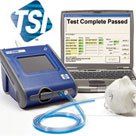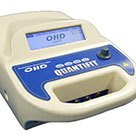Four Steps to Quantitative Fit Testing
If you use a negative or positive pressure tight-fitting respirator on the job, OSHA regulations say you need to be fit tested with the same make, model, style, and size of respirator you’ll use in your daily operations.
To stay in full OSHA compliance, these tests are supposed to be run before the first time you use the respirator on the job; whenever you change mask style, size, or model; if your physical condition changes that would affect mask fit (dental changes, facial cosmetic surgery, addition or removal of eyeglasses, or obvious changes in body weight). Then, you should be tested every year after that.
First, there are a few things you should know about respirator fit and the fit testing procedure.
Let’s start with the basics.
My mask has an assigned protection factor. Is it the same as a fit factor?
An assigned protection factor and a fit factor are not the same. An Assigned Protection Factor is the level of respiratory protection, as determined by the respirator manufacturer, that a respirator is expected to provide under standard working conditions. This is an overall standard for the respirator itself, and has nothing to do with the employee. A Fit Factoris a quantitative estimate of how well the respirator fits the intended wearer. A fit factor is the calculated ratio of contaminant concentration in the air to contaminant concentration inside the respirator. Different types of respirators have expected fit factors: OSHA requires that people wearing full face respirators must be able to minimally achieve a Fit Factor of 500 or better. For half face masks, the fit factor must be 100 or more. The two most frequently used types of quantitative fit testing are ambient aerosol nuclei count (CNC) and controlled negative pressure (CNP).
What’s the difference between CNC and CNP fit tests?
 Ambient Aerosol Nuclei Count (CNC), as implemented by TSI’s PortaCount family uses laser technology to measure aerosol concentrations inside and outside the respirator without the person having to stand in a test chamber or booth. The challenge agent measured consists of ambient microscopic dusts and aerosol particles that are in the air we breathe every day. The particle concentration outside the respirator is measured against the concentration inside the respirator, and the ratio of those two numbers is the fit factor.
Ambient Aerosol Nuclei Count (CNC), as implemented by TSI’s PortaCount family uses laser technology to measure aerosol concentrations inside and outside the respirator without the person having to stand in a test chamber or booth. The challenge agent measured consists of ambient microscopic dusts and aerosol particles that are in the air we breathe every day. The particle concentration outside the respirator is measured against the concentration inside the respirator, and the ratio of those two numbers is the fit factor.
 Controlled Negative Pressure (CNP), like the OHD QuantiFit creates a fixed vacuum on the face piece by temporarily cutting off the breathing air with special adapters. The instrument measures the airflow, or leak rate, needed to maintain the vacuum on the mask. The fit factor is computed by taking an average breathing rate and dividing that number by the measured leak rate. OSHA also requires CNP fit testing to include its REDON protocol. This protocol includes exercises performed facing forward and bending over, shaking the head and two removal and re-donning of the respirator facepiece.
Controlled Negative Pressure (CNP), like the OHD QuantiFit creates a fixed vacuum on the face piece by temporarily cutting off the breathing air with special adapters. The instrument measures the airflow, or leak rate, needed to maintain the vacuum on the mask. The fit factor is computed by taking an average breathing rate and dividing that number by the measured leak rate. OSHA also requires CNP fit testing to include its REDON protocol. This protocol includes exercises performed facing forward and bending over, shaking the head and two removal and re-donning of the respirator facepiece.
What’s involved in the test?
Not only does OSHA require fit testing, but it’s crucial in verifying the proper respirator selection and making sure each wearer understands how to use it. First, you’ll put on your mask and check for comfort and adequate fit.
- Does the mask sit properly across the bridge of your nose and against your cheeks?
- Is there room for eye protection or glasses (if needed)?
- Do you have room to talk?
- Is there adequate tension in the strap or is it too tight? Does the respirator slip out of position?
- Is the respirator the proper size to span the distance from your nose to your chin?
Then, regardless of which type of test you're doing, you’ll wear the mask for up to five minutes prior to the exercise test.
'The exercise test includes several one-minute activities, and a 15-second grimace (where you break the seal between the mask and your face, and then let it return to normal fit).
- Normal breathing
- Deep breathing
- Turning head side to side
- Lifting head up and down
- Talking out loud
- Grimacing (15 seconds)
- Bending and touching toes (or jogging in place)
- Normal breathing
So, which respirator fit test system should I use?
We say this: If you’re familiar with a specific brand, use it. We’ll support you either way. Both the TSI Portacount Pro 8030 and the OHD Quantifit are OSHA and NFPA accepted for tight-fitting respirators. But only the TSI PortaCount Pro+ 8038 is approved for testing N95 disposable masks (plus P1 and P2). So, if you’re testing N95 masks for hospital use, the TSI 8038 is the model you need.
There’s been some talk about the difference in speed between the two types of tests. If you’re only comparing TSI’s protocol for the exercise test and the OHD REDON protocol, there is a difference of 3-4 minutes per test, with the OHD being the faster of the two.
But with upgrades to TSI’s PortaCount firmware, you’re now able to link multiple PortaCount units together, and test up to four people simultaneously.
So again, it all comes down to your brand preference, and whether or not you need the ability to test N95s. The team at Raeco Rents is ready and willing to support you in using whichever model you need. Plus, we offer free video training on both the TSI and OHD models through our online Training Center.
Want to learn more?
- Read more posts on Respirator Fit Testing
- See the TSI PortaCount Pro
- See the OHD QuantiFit
